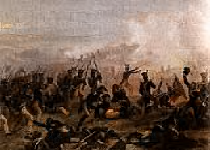 |
 Battle of Lundys Lane Battle of Lundys Lane |
 |
 Battle of Lundys Lane Battle of Lundys Lane |


Harvey Samuel Ludington was born in Phillipse Patent, Dutchess County, New York in 1796 to Zalmon and Phoebe (Simpkins) Ludington. His father passed away at a young age and his uncle, DeLaFayette Ludington, adopted the children. Harvey married Mary (Unknown) in 1816 and moved with his wife and his brothers and sisters and Uncle LaFayette to Indiana
They descended the Ohio river from a point near Pittsburg, Pennsylvania, on a "push boat", landing first at Shawneetown, Indiana and thence up the Wabash river to Vincennes, Indiana, where the party scattered, Harvey and his wife Mary moving to Danville, Vermilion County, Illinois.
Harvey and Mary had 6 children, Elsie b/1824, Phoebe b/1826, John Quincy Adams b/1829, Harvey Samuel b/1835, James b/1843 and Samuel b/1845.
Mr. Luddington received the appointment of Indian agent by the government and came over into Illinois. He served in this capacity for several years and then was appointed a government surveyor. He established all the important corners in this county, with Jonathan Kilbourn, deceased, as assistant, which have never been changed by other surveyors. Harvey handled the auctioneering chores during the sale of the original lots for the city of Danville, Illinois and taught in the first school along with Dr. Norton Beckwith and Enos Kingsbury. He rode over a greater portion of this state in the year 1817, working to have the state a free one, and it was his boast that was entitled to the honor when the state was declared anti-slavery.
He was a Democrat up to the time of the formation of the Republican party with which he afterwards affiliated.
Harvey was a Methodist of the old kind, and formed the first class meeting between Danville and Vincennes and carried in his pocket at all times an exhorters license.
Harvey served in the War of 1812, New York Militia, Captain Seymour Kellogg's Company and fought in the battle of Lundys Lane. He was a pensioner of the war (Pension # SC-5737). Harvey's younger brother Zalmon and cousin Archibald also served in the New York Militia during this war.

| PREVIOUS | HOME | NEXT |